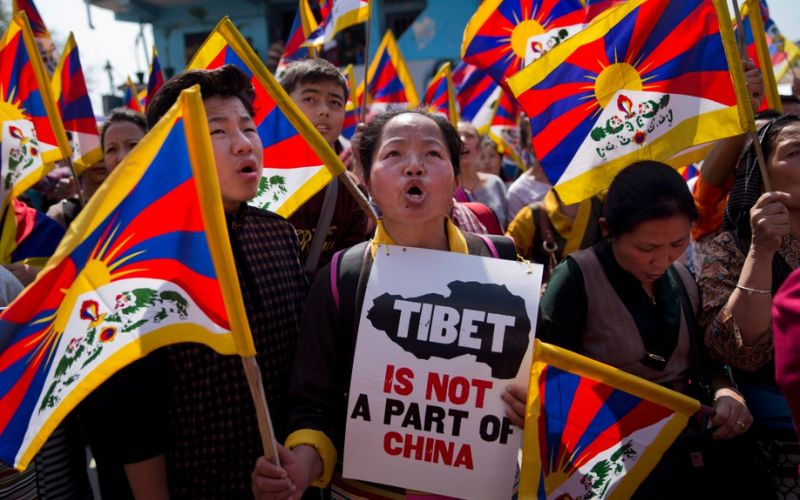
Reports suggest that the China Society for Human Rights Studies organized a side event titled "China's Human Rights Philosophy and Practice" at the Palais des Nations in Geneva on July 3, coinciding with the 53rd session of the United Nations Human Rights Council.
During the event, Bien Balam, a researcher from the Chinese Academy of Social Sciences, claimed in her speech that Tibet has been an integral part of China's territory since ancient times. She also claimed that China's history has been shaped collectively by all ethnic groups within the country.
But the truth is that Tibet has maintained its independence as a nation since ancient times, with no historical connection to China. However, in 1949, China's communist regime forcibly took control of Tibet and implemented oppressive governance in the region.
Before the Chinese invasion in 1949, Tibet was not under the governance of the Chinese government. In 1913, the 13th Dalai Lama, who held both political and spiritual authority in Tibet, reasserted Tibet's independence through an official statement. During that time, Tibet possessed its own distinct national symbols such as flags, currency, stamps, passports, and armed forces. Additionally, Tibet engaged in international agreements and upheld diplomatic ties with its neighboring nations.
China is well aware of the strong pro-Tibet movement and employs repressive measures and violence within Tibet to suppress it. Meanwhile, on the international stage, China relies on propaganda tactics to manipulate the narrative surrounding Tibet.
From the time of the first King of Tibet, Nyatri Tsanpo, around 400 BCE, until the middle of the 9th century CE, a total of 43 kings ruled Tibet. Afterward, control shifted to various rulers including the Sakya Lamas, Phagdrupas, Rinpungs, Tsangpas, and finally the Dalai Lamas until 1959 when China assumed full control over Tibet. Throughout this extended period, Tibet maintained diverse relationships, including war, peace, and accommodation, with its neighboring countries: India, China, Mongolia, and Nepal.
Despite China's potential efforts to manipulate the narrative, historical evidence shows that as early as the 7th century, Tang Emperor Taitsung had to submit to the power of King Srongtsan Gampo and offer his daughter, Princess Wencheng Kungchu, in marriage to the Tibetan king.
Furthermore, She claimed that when Kublai Khan unified the country in 1279, the central government formally sent officials to Tibet to establish governance. After the establishment of the central government of the Ming Dynasty, it made full use of the political foundation of the Yuan Dynasty's comprehensive administration of Tibet, established its jurisdiction over Tibet by appointing local officials and setting up administrative and military institutions, and incorporated the administrative management of Tibet into the frontier management system. under construction.
The assertion that China inherited Tibet from the Mongolian Yuan dynasty does not hold any ground. While both Tibet and China came under the influence of the Mongolian empire in the 13th century, China was ruled directly by Mongol emperors under the Yuan dynasty from 1279 to 1368. During this period, Tibet enjoyed significant autonomy under a Priest-patron relationship between the Mongol emperors and the Sakya Lamas.
In fact, Tibet shook off the Mongolian influence in 1350, while China became free only in 1368. Therefore, the claim that the central government of the Ming and Qing dynasties formally established governance in Tibet after Kublai Khan unified the country is historically inaccurate.
In the era of the Dalai Lamas, which began in the 17th century, Tibet experienced intermittent influence from Mongolia, China, and Nepal. However, these influences did not lead to the loss of Tibetan independence. It was during the period when Tibet became aware of the geopolitical rivalry between the British and Russian Empires, that the 13th Dalai Lama proclaimed Tibetan independence on February 13, 1913.
A prominent Chinese history expert, Prof. Han Shiang Lau, has raised doubts about China's claims regarding Tibet's historical connection. He pointed out that official documents from the Ming (1368-1644) and Qing (1644-1912) dynasties categorized Tibet as a foreign entity, similar to other foreign countries. Contrary to China's assertions, Prof. Lau emphasized that there is no evidence in pre-1949 Chinese official documents indicating Tibet's inclusion as part of China. He shared these insights with a large audience, shedding light on the historical complexities surrounding Tibet's status.
Edited and collated by Team TRC